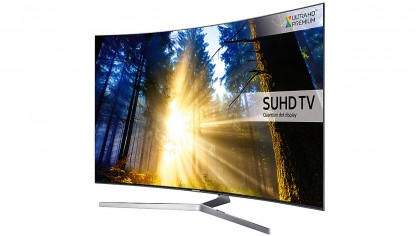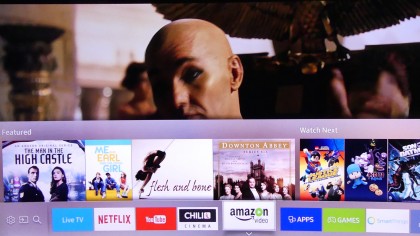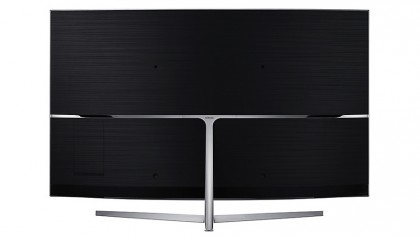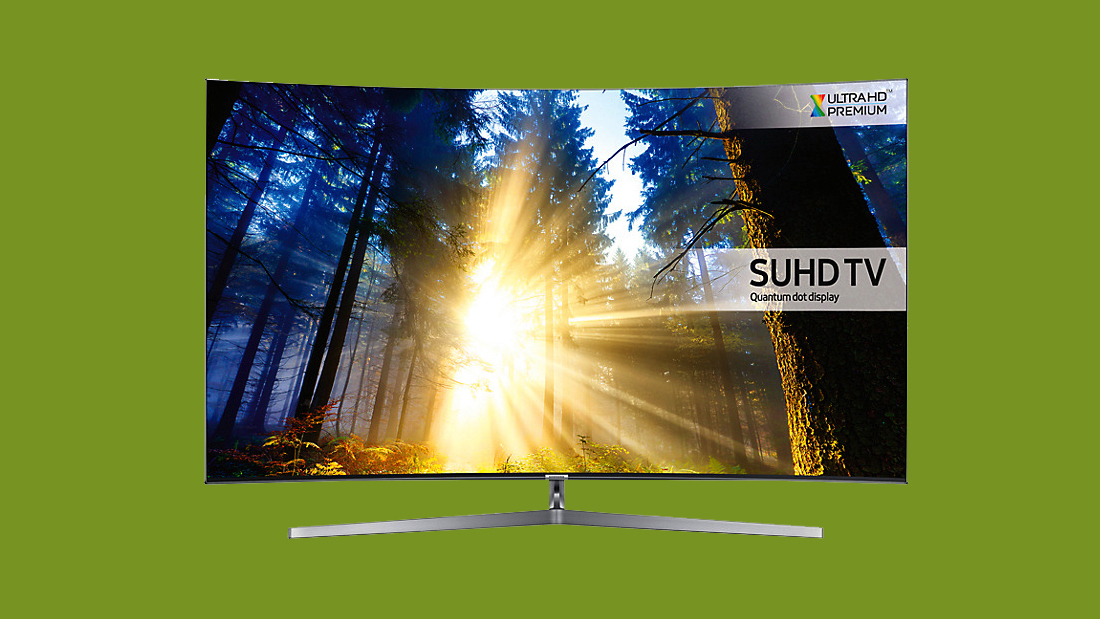Why you can trust TechRadar
Given the lengths Samsung has gone to in order to make the UE55KS9000 a premium HDR and UHD performer, it seems only polite to push it to its maximum potential right away by feeding it a selection of the new Ultra HD Blu-rays we're finally available to buy.
If you haven't seen HDR in action before, you'll probably struggle to stop your mouth involuntarily swinging open in slack-jawed amazement at the visual splendour that greets you from UHD BD titles like Kingsman: The Secret Service, Sicario and, especially, The Revenant. In fact, even if you have seen HDR in action before, unless you've seen one of Samsung's outstanding 2015 JS9500 models you've likely not seen it looking as outright spectacular as it looks on the UE55KS9000.
Amazing brightness and surprising colour
This amazing colour begins with the intense levels of brightness the UE55KS9000 can deliver, they're astonishing for a TV that's using edge LED lighting. This is especially true when it comes to the sort of brightness peaks that are one of HDR's trademarks. Stuff like sunlight, reflections off metallic or plastic surfaces, light bouncing off water, flames, explosions and so on enjoy a degree of intensity and punch far beyond anything possible with standard dynamic range content, instantly making pictures look more like what we see in real life.
There's also a generally brighter look to whole shots and scenes than you get with SDR (where that's the way the director wants them to look), and again this makes the on-screen action look both more intense and more natural.
Coupling the UE55KS9000's phenomenal brightness with Quantum Dot colour technology, meanwhile, results in a combination of HDR colour dynamism and finesse that's a joy to behold - and a million miles, again, beyond anything witnessed during the SDR age.
The extra punch of HDR's colours is at its most obvious during animated titles like the UHD Blu-ray of The Lego Movie, where the saturations and colour dynamics on show are so extreme versus the ordinary SDR Blu-ray that you almost feel you're watching a different film. But HDR's expanded and more finely delineated colours impact pretty much every frame of any HDR movie, be it in the extra credibility of skin tones, the extra richness of a blue sky, extra natural colouring and definition in the trees of a forest, and so on.
It's worth noting, too, that the extra colour finesse helps objects appear more solid and the sense of space and depth in a large scale shot look more profound.
Hugely impressive though the UE55KS9000's brightness is with HDR content, though, there's clearly a danger that its impact could be underlined by a significant reduction in black level response. After all, LCD's use of an external light system to illuminate pixels rather than each pixel producing its own individual light (cough, like OLED) doesn't bode well for a screen wanting to combine extreme light with extreme darkness.

Going behind the screen
However, the UE55KS9000's use of a newly designed panel plus potent local dimming (where different segments of the edge LED lighting can have their light outputs controlled individually) does a remarkably good job of delivering rich, deep black colours in the same frame as some of those incredibly punchy highlights I've been talking about. Samsung has long been at the forefront of producing strong contrast performances from LCD TVs, and the UE55KS9000 merely builds on this background. Well, mostly…
While the UE55KS9000's ferociously punchy and contrast-rich light engine works wonders with HDR content for most of the time, HDR's strident demands do uncover one problem: light banding, i.e. pockets of overly bright areas and pockets of dark areas.
To achieve the necessary 1000 nits of brightness from an edge LED TV Samsung has had to switch from using lights ranged down the vertical sides of its edge LED TVs to using lights ranged along its horizontal edges. But this means that if a predominantly dark picture contains a very bright HDR highlight towards its centre the TV's lights have to cast their light right down the image, causing a noticeable and defined vertical 'stripe' of light in the area of the bright object.
This sort of vertical light stripe is particularly hard to ignore if the film you're watching uses a wider aspect ratio than that of the 16:9 TV, and so needs to appear with black bars above and below the picture.
The impact of the light banding with HDR is much reduced if you're watching TV in a reasonably bright room; if what you're watching fills the 16:9 frame; and if you reduce the set's backlight a few levels. But for me movies are always best watched in a dark room; most films are made using wider ratios than 16:9/1.75:1; and if you reduce the backlight output you're no longer getting Samsung's optimised HDR picture experience.

To put all this in perspective, the sort of backlight issues I'm talking about are certainly not unique in the HDR TV world - in fact, Samsung's set actually handles the demands of HDR better than other edge-lit LED TVs. Also, I need to reiterate just how spectacular the UE55KS9000's HDR pictures look for the majority of the time - so the occasional backlight flaw might well be considered by many a fair price to pay for the general splendour on show.
At the same time, though, if you like watching films in a dark room and don't like to ever be distracted from what you're watching, the light banding issue is something you need to at least be aware of.
Rock-solid standard definition
Much as you might want to watch HDR all the time, HDR sources are currently thin on the ground. It's handy, then, that the UE55KS9000 looks fantastic with SDR sources.
Watching 4K SDR, for starters, really highlights a strength of the UE55KS9000's pictures I haven't mentioned yet: their exceptional sharpness. Detail levels are extreme without looking forced, big-scale scenes enjoy a sense of depth you don't get with mere HD images, and basically you're never in doubt that you're experiencing real UHD rather than HD. Samsung's motion processing is strong enough, too, to ensure that the excellent sense of resolution doesn't reduce much when there's motion in the frame.
Samsung's upscaling of HD, meanwhile, has arguably got even better than it was in 2015, converting HD Blu-rays and broadcasts into UHD with far more detail and texture and far less noise than you'd imagine possible considering how many millions of pixels are being added to the picture.

The colour and light control technologies the UE55KS9000 has introduced to boost its HDR performance also boost its SDR pictures, imbuing them with lovely subtle colour definition, an outstanding contrast range and a beautifully balanced look. What's more, since you can reduce the TV's backlight setting considerably with SDR without having to worry about upsetting the image's balance and light 'mapping', you can get even the darkest areas of SDR images looking gorgeously pure and free of backlight clouding and striping without crushing out shadow details.
One last element of the UE55KS9000's pictures worth mentioning is the impact of the curved screen. First, it's great to see that a new screen filter based on the way moth's eyes work has greatly reduced the distorted on-screen reflections that curved screens generally suffer with. Second, I really don't think the curve adds much to the viewing experience unless you're sat in exactly the right place. Finally, the curve can be problematic if one of your regular viewing positions is at an angle of more than around 40 degrees.
Current page: Picture quality
Prev Page Introduction and features Next Page Sound, value and verdictJohn has been writing about home entertainment technology for more than two decades - an especially impressive feat considering he still claims to only be 35 years old (yeah, right). In that time he’s reviewed hundreds if not thousands of TVs, projectors and speakers, and spent frankly far too long sitting by himself in a dark room.

